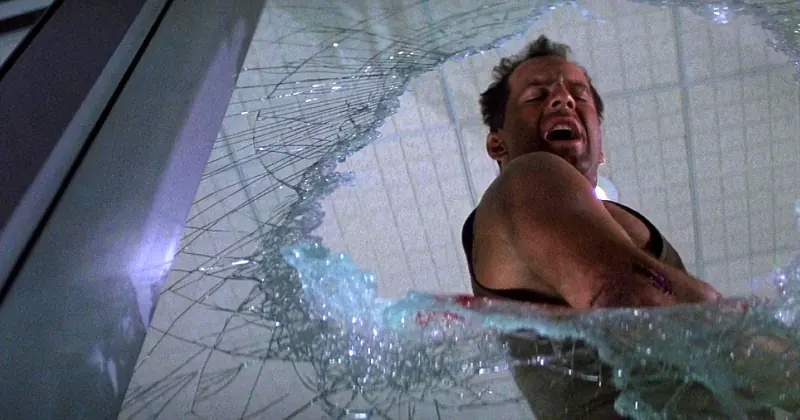Die Hard: Welcome To The Party, Pal!
Yippee-ki-yay...
DIE HARD contains all the evidence needed to send even the staunchest Hero's Journey skeptics on a vision quest. Its plot construction is perfect, the Hero transformation convincing and Jung himself would have drooled over the Hero-Shadow relationship.
The one quote everyone remembers is “Yippee-ki-yay, motherfucker” but my favorite moment of the movie is somewhat earlier, at the mid point to be precise.
INSIDE - OUTSIDE
Two sequences into Act Two, John McClane has failed twice to alert the outside world of the goings-on inside the Nakatomi Plaza. After setting off the fire alarm he witnesses the fire trucks turn back and when he radios the police, they choose to ignore him... until local beat cop Powell drops by. But Gruber's men deceive him and he can't detect anything suspicious.

Powell has cleared the Nakatomi building and steps into his car, humming "Let it snow," when a body lands on the car bonnet with an unholy slam, smashing the wind screen. McClane exclaims: “Welcome to the party, pal!” One of the countless moments of delightful irony in DIE HARD. Now the outside world knows.
IRONY AND SHADOW
The concept in itself is a brilliant case of cinematic irony: A lone NYPD cop has to stop a gang of European criminals in an LA skyscraper.
Past the mid point, the irony keeps stacking up. The reinforcements don't help John, in stead they make his life harder. Two FBI agents make all the wrong decisions (they're suitably named Johnson and Johnson, long before Tintin became mainstream in the US) and a journalist inadvertently exposes that Holly is John's wife.
The fact that Hans Gruber is John's mirror opposite is not just irony it is a brilliant rendition of the Shadow archetype. Gruber incorporates exactly those character traits John is lacking/suppressing and needs to assimilate before he can face his estranged wife again. John is impulsive; Gruber is thoughtful and calculated. To his wife, John acts like a male chauvinist brute; Gruber plays the charming, distinguished gentleman who treats women with dignity. When John shouts simple one-liners, Gruber speaks in articulate, elaborate sentences, betraying his education.
ASPECTS OF THE MID POINT
The Mid Point often signals a change of goals or a change in direction. John initially tried to alert the authorities; from here on he learns he will have to step up and take responsibility himself.
Around the mid point things usually get personal and it often involves the first face-to-face meeting of Hero and Shadow. Here too, John will soon bump into Gruber, who poses as a hostage.
A common archetypal image at the mid point is the jump off a cliff into the unknown, as in Butch Cassidy, Forgetting Sarah Marshall, The Incredibles etc.. John McClane doesn't jump off the 34th floor but he has a dead body do the job for him.
Like any truly great movie, a little digging reveals how DIE HARD was built on a solid foundation of mythical characters and an architecturally designed structure. We can all learn from this.
Karel Segers
Karel Segers wrote his first produced screenplay at age 17. Today he is a story analyst, script editor and producer with experience in rights acquisition, script development and production. His
screenwriting classes have trained writers in Australia, Europe, Asia and the Middle East, and his clients include international award-winning filmmakers as well as three Academy Award nominees.
Karel is the founder of
The Story Department and he ranks in the world's Top 10 of most influential people for screenwriting on Twitter.